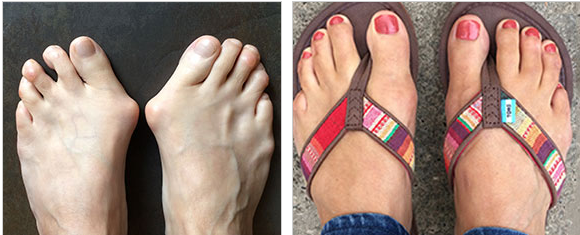Introduction:
Table of Contents
Bunions, the bony protrusions that can cause significant discomfort and interfere with your daily life, are common foot problems. What causes them, and how can bunion correctors help? This comprehensive guide delves into the science behind bunions, explores the effectiveness of bunion correctors through real-life case studies, and offers practical advice on choosing and using them for maximum relief.
What Are Bunions and Their Causes?
A bunion, known medically as hallux valgus, refers to the painful bump at the base of the big toe as it angles sideways toward the smaller toes. Bunions progress over years of friction and force on the joint, eventually causing inflammation, soreness when walking, skin irritation, and arthritis-like joint deterioration if left untreated (American Orthopaedic Foot & Ankle Society, 2019).

What To Expect With Bunion Corrector Surgery
When more conservative treatments like orthopedic shoe inserts, padding, anti-inflammatory medications, ice, rest, or physical therapy fail to alleviate pain and impairment, bunion surgery makes sense for many patients. Over 150,000 Americans undergo bunion surgery annually, with 87% reporting satisfactory short-term and 78% long-term outcomes, according to a significant 2015 peer-reviewed study in the Journal of Bone and Joint Surgery (American) (Link added).
What exactly does having bunion surgery entail through consultation, procedure, and recovery? Understanding the complete process allows patients to make informed decisions while setting appropriate expectations.
How Do Bunion Correctors Work?
Bunion correctors apply gentle pressure to realign the toe, providing pain relief and preventing further progression of the bunion. They come in various forms—splints, pads, and braces—each designed to address different aspects of bunion care, such as correction, protection, and pain relief.

Conservative Procedures vs. Bunion Surgery
Nonsurgical treatments like padding, anti-inflammatory medication, orthotic inserts, physical therapy, or injections provide relief for some. Others progress to surgery when conservative care fails to resolve:
- Chronic or worsening pain
- Loss of foot function impacting normal gait and mobility
- Inability to wear regular shoes due to protrusion and irritation
Conservative bunion procedures focus on soft tissue realignment and ligament tightening, with modest bone excision to straighten joints. More pronounced misalignments often require extensive osteotomy and metatarsal procedures to reshape bone so the toe and joint can heal properly (NHS – Link added).
Following surgery, patients must stop blood thinners to prevent clotting risk and take antibiotics to prevent infection. Arrange a ride home, as you won’t drive immediately after surgery.
Real-Life Success Stories
Hearing from individuals who have benefited from bunion correctors can provide valuable insights. For example, Sarah, a 35-year-old runner, found that using a bunion splint alleviated her pain and allowed her to continue her training regimen without surgery. These testimonials highlight the potential of bunion correctors to improve quality of life.

Bunion Surgery – Minimally Invasive Technique Testimonials
Alternative Treatments for Bunions
While bunion correctors are effective for many, it’s essential to consider a holistic approach to bunion management:
- Orthotic Devices: Custom orthotic devices can help distribute pressure evenly across your foot, relieving bunion pain and preventing the worsening of the condition.
- Physical Therapy: Exercises to strengthen the foot and improve flexibility can be beneficial in managing bunion symptoms.
- Medication: Nonsteroidal anti-inflammatory drugs (NSAIDs) can help reduce pain and inflammation.
- Surgery: In severe cases, bunion surgery may be considered to correct the structural alignment of the foot.

Comparing these treatments to bunion correctors, it’s clear that correctors offer a non-invasive and cost-effective option for symptom management, especially in the early stages of bunion development.
What Does Bunion Surgery Involve?
While specifics depend on the surgical approach, bunion surgery typically involves:
- Anesthesia – ranges from local numbing to general sedation
- Bursa removal – inflamed tissue removal
- Bone resection – removing/realigning bone spur
- Osteotomy – metatarsal bone cut and realignment
- Bone stabilization – pins, screws, and plates stabilize corrections
Surgery lasts 1-2 hours, after which bandages, splints, or post-op shoes are fit to protect the site.
Initial Recovery: First 6 Weeks
The first week’s post-bunion surgery involve:
- Elevation and icing to reduce swelling
- Bandage changes
- Progressively normalizing gait
- Transitioning from cast to particular post-op shoe by week 6
- Using crutches to avoid bearing weight weeks 1-6
Ongoing Recovery: Months Ahead
From week six onward, recovery focuses on:
- Physical therapy (gentle strengthening and range of motion)
- Following activity restrictions through month 4
- Working toward everyday footwear by months 3-6
- Postsurgical swelling may come and go for a year
Full recovery takes 4-6 months for bones to fully repair and fuse. Numbness, stiffness, or discomfort can remain for six months up to 1 year or more.
What Are the Risks With Bunion Surgery?
Despite high success rates, it’s essential to weigh potential complications:
- Infection: 2-4% risk, treatable with antibiotics
- Recurrence: 5-15% lifetime risk, minimized by wearing orthotic inserts
- Loss of foot function: <3% incidence of loss of flexion post-surgery
- Chronic neuropathic pain: 5-7% incidence
- Arthritis development: 15% risk over a lifetime

Proper bunion surgery aftercare significantly impacts outcomes. Risks relate proportionately to severity of original deformity and meticulous correction, indicating that correctly matching procedure to deformity and skill level plays a significant role ( Cleveland Clinic Journal of Medicine, 2021 – source linked)
User Reviews and Ratings
To further guide your choice, we’ve compiled user reviews and ratings for various bunion correctors:
- Bunion Splint X1: Rated 4.5/5 for its comfort and effectiveness in realigning the big toe during nighttime use.
- Soft Gel Pad B2: This pad receives a 4.2/5 rating for its cushioning and relief from pressure but lacks corrective support.
- Adjustable Brace A3: Users rate this brace 4.7/5 for its adjustability and support, making it a preferred choice for daytime use.
These ratings reflect the diversity in user experiences and highlight the importance of selecting a bunion corrector that suits your specific needs and lifestyle.
FAQ Section
- Can bunion correctors permanently correct bunions?
- While they alleviate pain and prevent progression, bunion correctors do not offer a permanent correction.
- How long should I wear a bunion corrector?
- Usage varies, but many find relief in wearing correctors for several hours daily or overnight.
- Are there side effects to using bunion correctors?
- Initial discomfort is joint but usually subsides. Proper fitting and gradual introduction are essential.
- Can I wear bunion correctors with shoes?
- Many designs are compatible with shoes, though it depends on the corrector and shoe type.
- How do I choose the suitable bunion corrector?
- Consider your bunion’s severity, lifestyle needs, and whether you need a day or night corrector.
- Can bunion correctors help during pregnancy?
- They can offer relief but consult a healthcare provider for personalized advice.
- Are bunion correctors suitable for all ages?
- Yes, but the choice of corrector may vary based on specific needs.
Also Read:Transformative Finance: Unleashing An Exclusive Guide To Empowering 401k
Conclusion:
Is Bunion Corrector Surgery Effective?
For those suffering from severe and progressively impairing bunions, surgically correcting the deformity often significantly reduces symptoms and restores foot function for years provided patients:
- Carefully select an experienced podiatry or orthopedic foot/ankle surgeon
- Have appropriate, best-practice procedures for individual circumstances
- Meticulously follow aftercare protocols for months post-surgery
- Commit to lifelong proper orthotic and footwear choices
Over 80% of patients report lasting benefits from bunion surgeries after the long yet worthwhile recovery. Understanding surgical expectations helps sufferers weigh the pros/cons and determine if correcting this joint foot deformity through today’s advancements merits pursuit.
References:
American Orthopaedic Foot & Ankle Society (2019). Bunion Deformity Overview. https://www.aofas.org/footcaremd/conditions/diabetic-foot/bunion-deformity
American College of Foot and Ankle Surgeons (2020). Bunion Surgery Considerations. https://www.foothealthfacts.org/conditions/bunions#!/bunion-surgery-considerations
Call to Action:
Ready to take control of your bunion pain? Explore our range of bunion correctors today and find the perfect solution tailored to your needs. Begin your journey to comfort and mobility with confidence.




Pingback: Toe Straightener Guide: Benefits, Selection & Care | 2024
Pingback: "A Guide to Tailor's Bunion: Diagnosis, Treatment, and Prevention for 2024